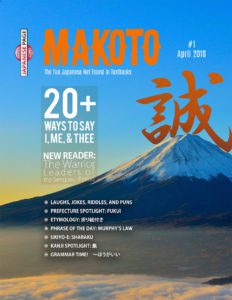
Welcome to Makoto, a digital magazine for learners of Japanese.
Whether you are just starting out or have a lot of experience under your obi, Makoto will surely please the lover of Japan and Japanese.
Enjoy articles on Japanese grammar, kanji, culture, haiku, and art. Each issue also includes two complete short stories with definitions, grammar explanations, and two MP3s of each story (normal speed and slower). One story is for beginners and one is for upper beginners to intermediates.
Yumi and I (Clay) hope you will enjoy this inaugural issue of Makoto. Please remember, the newer issues are bigger and better. Since launching two years ago, we have added more content and value to each issue. So, feel free to click the button below to download the PDF, ePub, Kindle MOBI, and MP3 sound files free of charge. Or you can access all of the content here online below the button.
If you like what you see, please click here to learn more or subscribe today for only $5 a month.
Or view the entire issue online below
In this Issue...
Introduction
Welcome to the first edition of MAKOTO, an e-zine that’s all about the Japanese language and culture.
Each issue will explore bite-sized articles on (hopefully) interesting aspects of Japanese not often found in Japanese textbooks.
Kanji, culture, idioms, proverbs, geography, history, etymology, JLPT tips, Japanese trivia, and much more. Yep. It will be a smorgasbord of fun (unless you don’t like Japanese, in which case, why are you even reading this far?).
Plus, every issue will include a brand new reader with newly recorded MP3s for you to download for no extra charge. (see below)
If you like what you see, click here to subscribe today: https://thejapanesepage.com/makoto
Clay & Yumi
P.S. “Makoto” means “truth” or “sincerity” in Japanese. The kanji is 誠 and is also our son’s name!

Laughs, Jokes, Riddles, and Puns
笑点
Shōten
Shōten is a Japanese TV program that has broadcasted every Sunday evening since 1966. The host presents questions or scenarios for the rakugo storytellers to react to. Funny or clever responses are rewarded with a zabuton (large floor cushion) for their efforts. If a member accumulates ten zabuton, he wins that day’s special prize. However, if the member’s reaction is in bad taste or falls flat, one or more zabuton can be taken away. Shōten can be a fun way for learners of Japanese to experience Japanese comedy. However, some topics require a good deal of cultural knowledge.
One of the silliest (and most loved) members is the yellow kimono wearing 林家 木久扇 Hayashiya Kikuō. A long running gag of his involves a pun on the word for roof, 屋根 yane. Whenever possible, he throws in this word and then says や~ね~ ya~ne~ — a show of disgust or unpleasantness. This usually results in a loss of a zabuton but always gains laughs.
BREAKDOWN:
笑点 shōten — Shoten, name of TV program [made of the kanji for “laugh” 笑 and “point” or “mark” 点]
屋根 yane — roof
や~ね~ ya~ne~ — terrible; unpleasant [this is a shortened form of いや iya (disagreeable; detestable) and the sentence ender ね ne which indicates emphasis or agreement.]
LEARN MORE:
Wikipedia Shōten Entry (English): https://en.wikipedia.org/wiki/Shōten
Shōten website (Japanese ): http://www.ntv.co.jp/sho-ten/index.html
Japanese Proverb
起承転結
kishou tenketsu
Introduction, development, turn, and conclusion
This is the order of a good story. A story has a beginning (起), develops (承), then turns (転), and is followed by a conclusion (結).

EXAMPLE:
小説を書くときは、起承転結が大切だ。
shousetsu o kaku toki wa, kishou tenketsu ga taisetsu da.
When writing a novel, the order of things is important.
書くとき kakutoki—when writing [書く kaku (to write) + とき toki (time)]
大切 taisetsu—important
Prefecture Spotlight
Fukui 福井
Japanese: 福井県 fukui ken
Capital: 福井市 Fukui City
Population: 803,755 (April 1, 2011)

DID YOU KNOW?
Set on the Sea of Japan, Fukui became a prefecture in 1871, the majority of it formerly being called Echizen. While a small prefecture population-wise, Fukui boasts of having a world-class Dinosaur Museum—the only one in all of Japan, a town (Sabae) that produces 90% of Japan’s eyeglasses, and several nuclear power plants that power about half of the Kansai regional power needs.
PLACES TO SEE:
· Ichijōdani Asakura Family Historic Ruins—an important archeological park of an area controlled by the Asakura clan during the Sengoku period. Oda Nobunaga (see this issue’s reader for more about him) defeated the Asakura family and burned the town down in 1573. Much of the town has been restored and is open to the public.
· Maruoka Castle—built in 1576, Maruoka Castle has the oldest still-standing keep in Japan.
· Fukui Dinosaur Museum—a world-class museum.
· Fukui Castle/prefectural government offices—while the government offices are built on the ruins of Fukui Castle, the moat and original walls make it a place to visit.
· Tōjinbō—an area of unique sea-side rock formations.
FAMOUS FOR:
· Eyeglasses—90% of Japan’s domestically-made glasses are made in Sabae.
· Papermaking—Washi no Sato has museums and places to experience traditionally made paper.
· Echizen Crab.
· Power—has fourteen nuclear reactors, more than any other prefecture. These supply about half of the Kansai Region’s needs.
· Dinosaurs—many dinosaur fossils have been found in Fukui.
語源 Etymology
折り紙つき
origami tsuki
Meaning: something very nice; certified to be good
Origin: First, it has nothing to do with origami. This “origami” refers to an official document certifying the authenticity of a sword (刀の鑑定書 katana no kanteisho). The tsuki means the sword comes with this guaranteed certificate. This paper was folded and thus called “ori” (to fold) “kami” (paper). It is now used to refer to objects in general.
Example:
このレストランのピザは、折り紙つきのおいしさです。
kono resutoran no piza wa, origami tsuki no oishisa desu.
this-restaurant-‘s-pizza-as for-guarantee-‘s-tastiness-is.
I guarantee you’ll love the pizza in this restaurant.
Phrase of the Day

Murphy’s Law in Japanese! What can go wrong?
失敗する可能性のあるものは、失敗する。
shippai suru kanōsei no aru mono wa, shippai suru.
If anything can go wrong, it will.
BREAKDOWN:
失敗する shippai suru – to fail; to make a mistake; to blunder
可能性 kanōsei – potentiality; likelihood; possibility
の no – ‘s (possessive marker)
あるもの aru mono – thing that exists; something
マーフィーは楽観主義者だった。
ma-fi- wa rakkan shugisha datta.
Murphy was an optimist.
BREAKDOWN:
マーフィー ma–fi– – Murphy
は wa – topic particle (marks the topic of the sentence)
楽観 rakkan – optimism
主義 shugi – “-ism”, principle, doctrine
者 sha – a person who does something. [医者 issha – doctor; 学者 gakusha – scholar; 芸者 geisha – geisha…]
だった datta – was (past simple)
Ukyo-e, the Art of the Floating World

Ukiyo-e was a 17th through 19th century Japanese artform that concentrated on images of everyday life. This included beautiful women, kabuki actors, sumo wrestlers, regular folk, landscapes, and famous scenes.
EVERYMAN’S ART
Many ukiyo-e artists produced woodblock prints which made mass production possible. This lowered the cost and opened art to the masses. Previously, only the wealthy could afford costly paintings.
GLOBAL INFLUENCE
Artists around the world were influenced by the Japanese ukiyo-e art. Degas, Monet, van Gogh, and Mary Cassatt incorporated the ukiyo-e style in their work.
SHARAKU
One of the most famous ukiyo-e artists was Tōshūsai Sharaku (東洲斎
写楽). He lived in the late 18th century and was known for his portraits of kabuki actors. The images below and on the next page are perhaps his most well-known.
Kanji Spotlight
Learning Kanji on Character at a Time

Grammar Time


休んだほうがいい 。
yasunda hō ga ii
It would be better to rest.
Construction:
(Informal Past Verb) + ほうがいい
Usage:
Use this form when giving advice or to suggest a course of action.
example:
あまり寝ていないなら、休んだほうがいいですよ。
amari neteinai nara, yasunda hō ga ii desu yo.
If you didn’t sleep well, it would be better to rest.
[あまり means “not very” and always ends with a negative: あまり寝ていない]
———————
行く前に、食べたほうがいい。
iku mae ni tabeta hō ga ii.
Before leaving, it would be best to eat something.
———————
もっとちゃんと勉強したほうがいいでしょう。
motto chanto benkyō shita hou ga ii deshō.
You should study harder.
[To use with する verbs such as 勉強, use the Informal Past した.]
休まないほうがいい 。
yasumanai hō ga ii
It would be better not to rest.
CONSTRUCTION:
(Informal Negative Verb) + ほうがいい
USAGE:
This does NOT use the past form of the verb. Use this to suggest not doing something.
EXAMPLE:
最近食べすぎなので、ケーキは食べないほうがいい。
saikin tabesugi na node, ke-ki wa tabenai hō ga ii.
Since you’ve eaten too much recently, it would be better to not eat that cake.
———————
高級な車は買わないほうがいい。
kōkyuu na kuruma wa kawanai hō ga ii.
It would be best to not buy an expensive car.
———————
健康のためにタバコは吸わないほうがいい。
kenkō no tame ni tabako wa suwanai hō ga ii.
For your health’s sake, you shouldn’t smoke cigarettes.
Japanese Pronouns
Japanese is famous for dropping pronouns. Once the topic or subject of a conversation is established, it is awkward to continually use the pronoun. And yet, ironically, there are tons of pronouns available for use—even more when considering dialects.
As mentioned above, you could, and in some cases should, avoid using pronouns altogether.
When the context is clear, drop the pronoun. When speaking to a superior, it is best to use the person’s name with an honorific such as さま sama or title such as 先生 sensei.
But a few well-placed pronouns can enliven a conversation. Want to sound like a sixteenth-century samurai warrior? There are pronouns for that. Want to sound more masculine? No problem. Like a little girl? Sure.
Notes on Pronouns
· When one says “I” in English no information is conveyed other than that it is first person singular. In Japanese, however, many pronouns also carry cultural, gender, or social status connotations.
· As long as the meaning is clear, Japanese usually omits the pronoun.
For example:
カールさんは店に行きました。
ka-ru san wa mise ni ikimashita.
Carl went to the store.
そこで、パンを買いました。
sokode, pan o kaimashita.
There, he purchased bread.
· Once the subject is clear, Carl, “he” is unnecessary in the second sentence even though it is required in English.
· Single words or short sentences usually drop the pronoun as it is assumed the speaker is referring to him or herself.
Example:
腹減った。 hara hetta. (I’m) hungry.
眠い。 nemui. (I’m) sleepy.
· Adding the suffix, たち tachi, to the first person pronoun, makes it plural: 私たち watashi tachi we; us.
· The suffix ら ra is a more informal version of たち tachi.
· While you can say 彼女たち kanojo tachi when the room is full of women or girls, the norm is to use 彼ら karera for mixed groups or situations when the gender makeup of the group is unknown.
How to NOT Use Pronouns
You can get by your entire life with only using 私 watashi for “I” and あなた anata for “you,” but not only would that be boring, in some situations it might actually be rude. あなた anata, for example, can, in some cases, be rude since it implies you are stating the listener is equal to or inferior to you. Saying 私 watashi too often can make one sound conceited.
Here are a few ways to get around this:
INSTEAD OF 私 watashi
· Point to yourself when referring to yourself
INSTEAD OF あなた anata
· Use the person’s name with さん san
· Use the person’s title: 先生 sensei (for teachers, doctors, pastors, and other teaching professions); 社長 shachō (for bosses or company presidents)
· そちら sochira literally means “there” and can be used to refer to your listeners
INSTEAD OF PLURAL PRONOUN
· Refer to everyone as みんな or みなさん
In short, if you can avoid using a pronoun whether through context or substitute, do it.
Now, let’s look at actual pronouns!
Everyday Use Pronouns
私 watashi—I; me [formal or informal; gender-neutral]
うち uchi—one’s own… [usually used with の to talk about one’s household: うちの犬 uchi no inu—my (our) dog]
あなた anata—you [usually said to people on a similar or lower social status; often used by wives to address their husbands like “dear” or “sweetheart”]
君 kimi—you [informal; used among friends; the same kanji is used as the name suffix -kun. Often used with 僕 boku.]
彼女 kanojo—she; her [can also be used to mean “girlfriend.”]
彼 kare—he; him [can also be used to mean “boyfriend.” 彼氏 kareshi always means “boyfriend.”]
Formal Pronouns
私 watakushi—I; me [more formal then just watashi; uses the same kanji as watashi; gender-neutral]
我 ware—I; me [literary style]
我ら warera—we [literary style]
我が waga—my (or can be plural: our as in 我が社 wagasha—our company) [gender neutral]
我々 ware ware—we [formal; used when speaking on behalf of a company or group]
Pronouns for Women
あたし atashi—I [a shortened form of watashi used commonly by women]
Pronouns for Men
俺 ore—I [gives a sense of masculinity; can be rude in some situations]
僕 boku—I [used by males of all ages, but particularly with boys. Can be used when calling a boy whose name you don’t know: “hey, kid” or “hey, squirt.” The kanji 僕 shimobe means “servant”]
儂 washi—I [often used by older males]
Archaic Samurai Edo Period “the Fun” Pronouns
あっし asshi—I; me [Edo period slang for 私 watashi]
拙者 sessha—I; me [used by males; samurai pronoun; the kanji means “clumsy person”]
我が輩 wagahai—I; me [used by males; has a nuance of arrogance; Natsume Soseki’s famous book, I am a Cat is called 吾輩は猫である wagahai wa neko de aru.]
某 soregashi—I; me [used by males; used by samurai as a first person pronoun, but literally means some unknown person]
余 yo—I [used by males] Say this after a good meal: 余は満足じゃ。 yo wa manzoku ja. I am satisfied.
己 onore—I; oneself [used by males; humble when used as first person pronoun, but hostile when used as a second person pronoun (see below)]
汝 nanji—you [used by males and females]
Pronouns for When Upset
あんた anta—you [rude; a shortened version of あなた anata; used when angry]
おまえ omae—you [can be rude or can show familiarity similar to 俺 ore. Often used by husbands when speaking to their wives]
てめえ temee—you [rude; used when angry; used by males; also てまえ temae; kanji: 手前]
きさま kisama—you [rude; historically, this was a formal pronoun the kanji, 貴様 meaning an honorable person]
こいつ koitsu—him; her [informal; implies contempt; used to refer to someone nearby]
あいつ aitsu—him; her [informal; implies contempt; used to refer to someone away from the speaker and listener.]
おのれ onore—you [used by males; humble when used as first person pronoun, but hostile when used as a second person pronoun]
Less Common Pronouns
おら ora—I [rural feel; used in anime or manga such as Crayon Shinchan and Dragon Ball characters]
我ら warera—we [informal; like たち tachi, ら ra is a pluralizing suffix that usually shows familiarity]
Plural Suffixes
~たち ~tachi [informal: 私たち watashi tachi—we; 君たち kimi tachi—you; can also be added to names、groups, or places: 青木さんたち aoki san tachi—the Aoki’s]
~ら ~ra [informal: 彼ら karera—they; あいつら aitsura—they; ]
~とも ~tomo [humble; changes to ~domo; わたくしども watakushi domo]
~かた ~kata [formal; changes to ~gata; あなたがた anata gata—you (plural; more formal than あなたたち anata tachi]
Other
あの人 ano hito—he; she [literally, that person; informal to formal]
あの方 ano kata—he; she [literally, that person; formal / polite]
あの子 ano ko—she [literally, that child, but usually refers to a girl or young woman]
我が社 waga sha—our company [used when representing one’s own company]
Did you enjoy this? Was it helpful? Get instant access to Makoto by becoming a member today.









